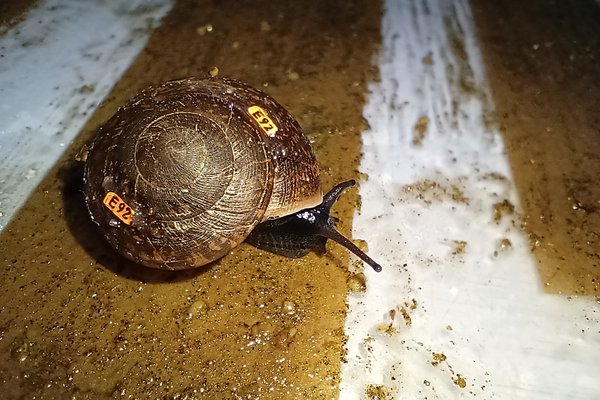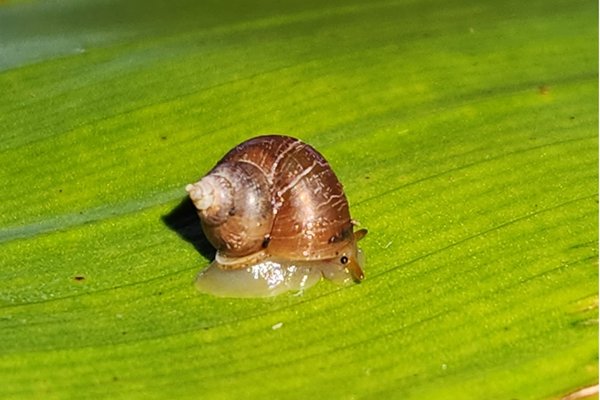Rare snail species found alive on Norfolk Island after 130 years
The tiny, enigmatic snail was last collected in 1889 and is currently listed as extinct by the International Union for Conservation of Nature (IUCN). So, we were very excited to find Nancibella quintalae alive on Norfolk Island!
Recently, Frank Köhler from the Australian Museum Research Institute, Brett Finlayson from Taronga Zoo and I travelled to Norfolk Island. Our aim was to survey the endemic snails, with particular focus on the largest species which are Critically Endangered due to predation by rodents and chickens. Little did we know that the most exciting moment would come from finding a much smaller species, long thought to be extinct!

Nancibella quintalae, until now thought to be extinct.
Image: Frank Köhler© Frank Köhler
Norfolk Island is a small and isolated island, lying in the Pacific Ocean between Australia, New Zealand and New Caledonia. It has a rich diversity of endemic land snails, with around 70 species recorded that are unique to this island. These species range in size from 1 mm to 22 mm in shell diameter and encompass a stunning variety of shapes, sizes and colours. However, many of the species are in decline due to land clearing and the introduction of exotic predators. This has led to the likely extinction of several species on Norfolk Island and neighbouring Phillip Island.
The elusive Nancibella quintalae is approximately 4 mm in shell diameter. Like many of the other small native snails, it lives in leaf litter in the palm-dominated rainforests of Norfolk Island National Park. On the underside of a dead palm frond, in among the more common species, I spotted one individual that looked different. The distinguishing feature of Nancibella quintalae is that its shell has many more coils, or whorls, than other similar-sized Norfolk Island endemics. This leads us to believe that it may even belong to a separate family. Unfortunately, we only found just a single specimen – however, we hope that future surveys reveal more about the size of the population.

Palm forest on Norfolk Island.
Image: Isabel Hyman© Isabel Hyman
We were also able to provide an update on the status of five Critically Endangered species, all in the larger size range (10-22 mm in shell diameter) and therefore, prime targets for the introduced rodents and chickens. For two of these species, Advena campbelli and Mathewsoconcha belli, we were able to confirm that the populations are still extant. While still limited to a single population, Advena campbelli has expanded its numbers during recent favourable weather conditions, but Mathewsoconcha belli is still in a very precarious position, with only three living specimens observed. We are currently working with Taronga Zoo, Parks Australia and the Norfolk Island Regional Council to develop a captive breeding program for these Critically Endangered species, to prevent imminent extinction in the wild.

Advena campbelli on a dead palm frond.
Image: Isabel Hyman© Isabel Hyman
The other three Critically Endangered species were last recorded from nearby Phillip Island, which has never harboured introduced rodents, but had its vegetation decimated by introduced pigs, goats and rabbits in the early to mid-1900s. When these pests were eradicated in 1980, the island was almost completely denuded of vegetation, exposing its red soil to erosion. Since then, vegetation has gradually returned, and amazingly, with them, populations of some endemic species – including a gecko, a skink and a giant centipede, and several endemic plants. Anecdotal evidence suggests that the same may be true of three native snail species. However, we saw evidence of just a single species, only represented by bleached shells that may have been long-dead. Repeated surveys may reveal whether this species still lives on Phillip Island.
We hope to return to Norfolk Island in December, to check up once again on how the native land snails are faring and to collect Mathewsoconcha belli for our proposed captive breeding program. You can be sure we’ll be keeping our eyes peeled for any further signs of the rare Nancibella quintalae – so watch this space!
Dr Isabel Hyman, Scientific Officer, Malacology, Australian Museum Research Institute
More information:
- Hyman, I. 2020. Raised from the dead: Species assumed extinct rediscovered on Norfolk Island. Australian Museum blog.















